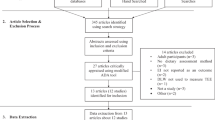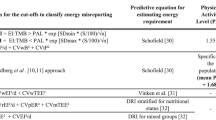Abstract
Objective:
The aim of this study was to validate intake of energy, macro- and micronutrients assessed from pre-coded food diaries (PFDs) by using weighed records (WRs) as the reference method among a group of Norwegian 9-year-olds. We also examined how under-reporters (UR) differed from acceptable reporters (AR) according to the energy intake during the 4-day recording period and energy intake distribution during the day.
Subjects and design:
One hundred 9-year-olds, 45 girls and 55 boys, were recruited to complete a 4-day record with a PFD followed 3 days later with a 4-day WR.
Results:
There were no differences between energy and nutrient intake from the two recording methods among boys, but girls reported significantly higher intakes with PFD compared with WR. The median Spearman correlation coefficient between PFD and WR for energy and nutrients was 0.43 for girls and 0.49 for boys. Twelve participants were classified as UR with the PDF method. Energy percentages from macronutrients were not significantly different between UR and AR with the PFD method. UR had significantly lower energy intake in the last two recording days and from 1000 to 2200 hours during the day compared to AR.
Conclusions:
The PFD method is promising as a tool for assessing food intake in large surveys among children. The present study indicates that the PFD gives more valid data for boys than girls according to the group intake and ranking of nutrient intake when WR is the reference method. However, UR seemed to develop a study fatigue during the day and during the recording period. Increased awareness about the tendency of study fatigue can lead to more specific instructions on how participants can handle the problem.
This is a preview of subscription content, access via your institution
Access options
Subscribe to this journal
Receive 12 print issues and online access
$259.00 per year
only $21.58 per issue
Buy this article
- Purchase on Springer Link
- Instant access to full article PDF
Prices may be subject to local taxes which are calculated during checkout




Similar content being viewed by others
References
Andersen LF, Nes M, Bjørneboe G-EAa, Drevon CA (1997). Food habits among 13-year-old Norwegian adolescents. Scand J Nutr 41, 150–154.
Andersen LF, Nes M, Lillegaard IT, Sandstad B, Bjørneboe G-EAa, Drevon CA (1995). Evaluation of a quantitative food frequency questionnaire used in a group of Norwegian adolescents. Eur J Clin Nutr 49, 543–554.
Bandini LG, Schoeller DA, Cyr HN, Dietz WH (1997). Validity of reported energy intake in preadolescent girls. Am J Clin Nutr 65 (Suppl), 1138S–1141S.
Becker W, Lennernäs M, Gustafsson I-B, Haraldsdóttir J, Nydahl M, Vessby B et al. (1998). Pre-coded food records compared with weighed food records for measuring dietary habits in a population of Swedish adults. Scand J Nutr 42, 145–149.
Berenson GS (2002). Childhood risk factors predict adult risk associated with subclinical cardiovascular disease: The Bogalusa heart study. Am J Cardiol 90 (Suppl), 3L–7L.
Bingham SA, Gill C, Welch A, Day K, Cassidy A, Khaw KT et al. (1994). Comparison of dietary assessment methods in nutritional epidemiology: weighed records v. 24 h recalls, food-frequency questionnaires and estimated-diet records. Br J Nutr 72, 619–643.
Black AE (2000). Critical evaluation of energy intake using the Goldberg cut-off for energy intake: basal metabolic rate. A practical guide to its calculation, use and limitations. Int J Obes 24, 1119–1130.
Black AE, Cole TJ (2001). Biased over- or under-reporting is characteristic of individuals whether over time or by different assessment methods. J Am Diet Assoc 101, 70–80.
Black AE, Goldberg GR, Jebb SA, Livingstone MBE, Cole TJ, Prentice AM (1991). Critical evaluation of energy intake data using fundamental principles of energy physiology: 2. Evaluating the results of published surveys. Eur J Clin Nutr 45, 583–599.
Bland JM, Altman DG (1986). Statistical methods for assessing agreement between two methods of clinical measurement. Lancet 8, 307–310.
Commission of the European Communities (1992). Reports of Scientific Committee for Food: Nutrient and Energy Intakes for the European Community. (Thirty-First Series of Food – Science and Techniques). Office for Official Publication of the European Communities: Luxembourg.
de Castro JM (1997). Prior day's intake has macronutrient-specific delayed negative feedback effects on the spontaneous food intake of free-living humans. J Nutr 128, 61–67.
de Castro JM (2004). The time of day of food intake influences overall intake in humans. J Nutr 134, 104–111.
Gersovitz M, Madden JP, Smiciklas-Wright H (1978). Validity of the 24-hr. dietary recall and seven-day record for group comparisons. J Am Diet Assoc 73, 48–55.
Goldberg GR, Black AE, Jebb SA, Cole TJ, Murgatroyd PR, Coward WA et al. (1991). Critical evaluation of energy intake data using fundamental principles of energy physiology: 1. Derivation of cut-off limits to identify under-recording. Eur J Clin Nutr 45, 569–581.
Hartman AM, Brown CC, Palmgren J, Pietinen P, Verkasalo M, Myer D et al. (1990). Variability in nutrient and food intakes among older middle-aged men. Am J Epidemiol 132, 999–1012.
Hustvedt B-E, Christophersen A, Johnsen LR, Tomten H, McNeill G, Haggarty P et al. (2004). Description and validation of the ActiReg®: a novel instrument to measure physical activity and energy expenditure. Br J Nutr 92, 1001–1008.
Johnson RK, Driscoll P, Goran MI (1996). Comparison of multiple-pass 24-hour recall estimates of energy intake with total energy expenditure determined by the doubly labeled water method in young children. J Am Diet Assoc 96, 1140–1144.
Larkin FA, Metzner HL, Guire KE (1991). Comparison of three consecutive-day and three random-day records of dietary intake. J Am Diet Assoc 91, 1538–1542.
Lillegaard ITL, Andersen LF (2005). Validation of a pre-coded food diary with energy expenditure, comparison of under-reporters v. acceptable reporters. Br J Nutr 94, 998–1003.
Lillegaard ITL, Øverby NC, Andersen LF (2005). Can children and adolescents use photographs of food to estimate portion sizes? Eur J Clin Nutr 59, 611–617.
Livingstone MBE, Robson PJ (2000). Measurement of dietary intake in children. Proc Nutr Soc 59, 279–293.
Livingstone MBE, Prentice AM, Coward WA, Strain JJ, Black AE, Davies PSW et al. (1992). Validation of estimates of energy intake by weighed dietary record and diet history in children and adolescents. Am J Clin Nutr 56, 29–35.
Livingstone MBE, Robson PJ, Black AE, Coward WA, Wallace JMW, McKinley MC et al. (2003). An evaluation of the sensitivity and specificity of energy expenditure measured by heart rate and the Goldberg cut-off for energy intake: basal metabolic rate for identifying mis-reporting of energy intake by adults and children: a retrospective analysis. Eur J Clin Nutr 57, 455–463.
Lytle LA, Nichaman MZ, Obrzanek E, Glovsky E, Montgomery D, Nicklas T et al. (1993). Validation of 24-hour recalls assisted by food records in third-grade children. J Am Diet Assoc 93, 1431–1436.
McGill Jr HC, McMahan CA, Herderick EE, Malcom GT, Tracy RE, Strong JP (2000). Origin of atherosclerosis in childhood and adolescence. Am J Clin Nutr 72 (Suppl), 1307S–1315S.
Nordic Nutrition Recommendations (2004). Integrating Nutrition and Physical Activity vol. 13 Nordic Council of Ministers: Copenhagen, p 111.
Øverby N, Andersen LF (2002). Ungkost 2000. Landsomfattende kostholdsundersøkelse blant elever i 4.- og 8 klasse i Norge. Report in Norwegian. Sosial – og helsedepartementet: Oslo, Norway.
Øverby NC, Lillegaard ITL, Johansson L, Andersen LF (2004). High intake of added sugar among Norwegian children and adolescents. Public Health Nutr 7, 285–293.
Rebro SM, Patterson RE, Kristal AR, Cheney CL (1998). The effect of keeping food records on eating patterns. J Am Diet Assoc 98, 1163–1165.
Rimestad AH, Løken EB, Nordbotten A (2000). The Norwegian food composition table and the database for nutrient calculations at the Institute for Nutrition Research. Norw J Epidemiol 10, 7–16.
Schofield WN, Schofield C, James WPT (1985). Basal metabolic rate: review and prediction. Hum Nutr Clin Nutr 39 (Suppl 1), 1–96.
Subar AF, Kipnis V, Troiano RP, Midthune D, Schoeller DA, Bingham S et al. (2003). Using intake biomarkers to evaluate the extent of dietary misreporting in a large sample of adults: The OPEN Study. Am J Epidemiol 158, 1–13.
Tarasuk V, Beaton GH (1991). The nature and individuality of within-subject variation in energy intake. Am J Clin Nutr 54, 464–470.
WHO (1985). Energy and protein requirements. Report of a Joint FAO/WHO/UNU Expert Consultation WHO Technical Report Series, No. 724 WHO: Geneva, pp 71–112.
Wilson AMR, Lewis RD (2004). Disagreement of energy and macronutrient intakes estimated from a food frequency questionnaire and 3-day diet record in girls 4 to 9 years of age. J Am Diet Assoc 104, 373–378.
Acknowledgements
This study was funded in part by the EXTRA funds from the Norwegian Foundation for Health and Rehabilitation through Norwegian Health Association.
Author information
Authors and Affiliations
Corresponding author
Additional information
Guarantor: ITL Lillegaard.
Contributors: ITLL contributed to study design, data collection, data analysis and writing of the paper. EBL contributed to data analysis and writing of the paper. LFA contributed to study design, data analysis and writing of the paper.
Rights and permissions
About this article
Cite this article
Lillegaard, I., Løken, E. & Andersen, L. Relative validation of a pre-coded food diary among children, under-reporting varies with reporting day and time of the day. Eur J Clin Nutr 61, 61–68 (2007). https://doi.org/10.1038/sj.ejcn.1602487
Received:
Revised:
Accepted:
Published:
Issue Date:
DOI: https://doi.org/10.1038/sj.ejcn.1602487
Keywords
This article is cited by
-
Evaluation of 2 × 24-h dietary recalls combined with a food-recording booklet, against a 7-day food-record method among schoolchildren
European Journal of Clinical Nutrition (2011)
-
The influence of dietary intake and meal pattern on blood glucose control in children and adolescents using intensive insulin treatment
Diabetologia (2007)



